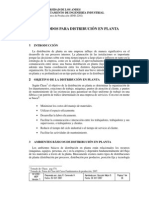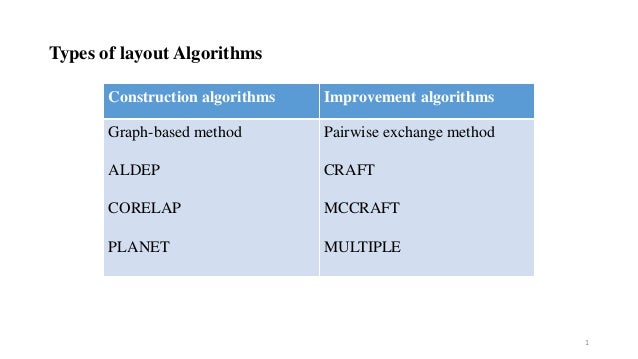Download Note - The PPT/PDF document 'AUTOMATED LAYOUT DESIGN PROGRAM (ALDEP)' is the property of its rightful owner. Permission is granted to download and print the materials on this web site for personal, non-commercial use only, and to display it on your personal computer provided you do not modify the materials and that you retain all.
Click the file below
- To download ALDEP SOFTWARE, click on the Download button To obtain a layout. The Automated Layout Design Program ALDEP aldep. By D Page 1980 — objective function used to measure the efficiency of layouts for purposes of. The second program, ALDEP (Automated Layout Design Pro gram).
- Download Note - The PPT/PDF document 'AUTOMATED LAYOUT DESIGN PROGRAM (ALDEP)' is the property of its rightful owner. Permission is granted to download and print the materials on this web site for personal, non-commercial use only, and to display it on your personal computer provided you do not modify the materials and that you retain all.
- To download ALDEP SOFTWARE, click on the Download button. You canor from softwarr own site. Apply ALDEP algorithm to design a suitable layout. Aldep software Layout Design Program aldep software How is Persona 2 tsumi torrent Layout Design Program abbreviated? ALDEP is quite similar to CORELAP except for the fact that it.
Click 'Yes'
Select Install to start the installation process
Click OK after selecting the parameters you need.
Select Done and you have successfully installed WinRAR!


Click 'Save File'
Click 'Downloads
Click the installer

Click 'Yes'
Select Install to start the installation process
Click OK after selecting the parameters you need.
Select Done and you have successfully installed WinRAR!
Click 'Run'
Click 'Yes'
Select Install to start the installation process
Click OK after selecting the parameters you need.
Select Done and you have successfully installed WinRAR!
Click 'Run'
Click 'Yes'
Select Install to start the installation process

Download Software Aldep Pro
Click OK after selecting the parameters you need.
Select Done and you have successfully installed WinRAR!
Video Download Software
A. Project Files | |
DSS This program is entitled Decision Support Methodology for Integrated Production Systems. This program is described in the appendix of Chapter 3. This decision support program enables the user to determine the unit cost of producing a product which has number of parts. The application is designed in Visual Basic Version 6.0. It also uses MS Access application for its database requirements. Modules Material Selection and Cost Estimation [download ] | |
MHS Material Handling Equipment Selection and Cost Estimation Another set of user inputs are obtained to further classify the chosen type of the Material Handling Equipment. Cost information pertaining to the specific MHE is obtained from a MS Access database (PicSource.mdb) present in the backend of the application. [download ] | |
MC Machine Selection and Cost Estimation is another decision support system included with the textbook. It is primarily described in the appendix og Chapter 3. It is a separate database application (MC.mdb) that has been created in Microsoft Access. It has a wide range of machines for each of the commonly used manufacturing processes. Each record in the database provides specific information about the type of the machine, its dimensions and other attributes, capacity and cost. This database application provides the user with necessary information and helps the user in the selection of appropriate machinery. Standard time Estimation The forms (Turning, Milling, and Drilling) are specifically designed to calculate the standard times for each of these processes. These Standard time(s) information supplemented by information on availability factor, percentage of non-defective product produced and unit cost of machinery is used to calculate the ‘machine component’ of the total cost. [download ] | |
| Documentation/MS Word/PDFs description here [download ] | |
B. Layout Tools | |
LAYOUT FLAP - Facility LAyout Program (FLAP) is an computer application for the facility layout design problem. The program is similar to the commercially available layout design package CRAFT. The application tool uses an Activity Relationship Matrix or the Trips between Departments to recommend the Layout of the facility. The tool provides options to build relationship charts between the number of departments specified, and input from-to and relation charts in the form of a text file in case of more number of departments. The program then assigns suitable weights to the various departments and ranks them according to the number of A, E, I, O and U relationships. The program then takes in the area of the facility and the individual department areas. The output of the program is to position the various departments based on the closeness rank within the specified layout area. The program recommends two alternate layouts and also provides the scoring for each of the layouts based on a scoring model. The application falls under the category of computerized layout programs, which automates the layout generation. The program provides two alternative layout designs for the problem based on the relation or trips information within the specified area. However the design alternative provided may not be the optimal for the specified conditions. FLAP just aids the user in making a decision regarding the facility layout, by acting as a Decision Support System Tool (DSST).[download ] | |
GMAFLAD - Multi-Attribute Facility Layout and Design (MAFLAD) is a computer program that was introduced by Smith and Macleod in 1988. MAFLAD solves the problem of physically organizing a number of entities within a given facility to optimality by means of an underlying branch and bound algorithm. The approach chosen with MAFLAD is based on the Quadratic Set Packing (QSP) model, which offers various computational advantages over the more general Quadratic Assignment Problem (QAP), which was first introduced by Koopmans and Beckmann in 1957 to model the assignment of indivisible resources to a given set of locations [download ]. | |
STEPSample-Test Pairwise Exchange Procedure (STEP) In the following, we have the facility layout STEP algorithm of Li and Smith, which is a hybrid of a graph theoretic and improvement approach using an underlying steiner circulation flow graph to estimate the congestion in the layout, and a sampling design scheme to perturb the arrangement of the activities. It has been extensively tested against the standard Quadratic Assignment Problem (QAP) test problems (without congestion modeling) but it also has the capability of modeling | |
C. Analysis Tools | |
GQnet is an analytical tool used to model open queuing networks with multiple product types and multiple sources. The tool, GQNET, is an extension of the queuing network model QNET presented by J. M. Smith, R. J. Graves and L. Kerbache in a paper in 1986 . QNET was primarily used to model the flow of products in a material handling system and considered only queues with infinite buffer capacity. GQNET, however, can be used to model pedestrian traffic flow as well as the flow of products and it can also account for blocking in queuing networks to a certain extent caused by finite buffers. GQNET also has an easy-to-use graphical user interface which allows the user to model any network topology with no difficulty. [download ] | |
CNET - Closed Queueing Network Procedure The CNET algorithm is a closed queueing network procedure as described in Chapter 8 of the textbook. It represents a finite queueing network closed loop model where there is a finite population N of carriers or pallets and finite buffers at all the queues. Various performance measures are output for the entire network (including cycle time and throughput) and all the performance measures for the nodes in the network. Users can alter the cost parameters and network topology of the model as needed. [download ] | |
D. Simulation Tools | |
Cellular Layout Simulation Model This cellular layout simulation model is described in Chapter 8 of the textbook.It demonstrates the movement of the single worker in the work cell along with performancemeasuresof machine utilization, cycle time, throughput and queues of parts in the cellular layout.This is a good example of a ``one-piece' part flow process.The simulation model runs for one 7.5 hour shift and a number of alternative designsfor the layout with certain conditions are included.There are a number of files with this download, please view the readme file for furtherinstructions. [ download ] | |
Warehouse Simulation Model The warehouse simulation model is described at the end of Chapter 8in the textbook. The simulation model shows the movement of forklifttrucks in the facility along with the movement of the polymerstorage units (gaylords) and their storage location housed in thefacility.Various performance measures are also collected for theorders and inventory of the storage units (gaylords), utilization ofmachines, and forklifts.This is a good example of a floor storagewarehouse model. The downloaded simulation model is an .avi file. It is called `` polymer-processing.avi' and you should download this .avi file, double click on it and run it with windows media player or a similar software tool. [ download ] | |
Office Planning Simulation Model The office planning simulation model is extensively described inChapter 11 of the textbook. The simulation model shows the dynamicflows of the customers for the first office facility plan describedin the textbook.It also indicates the parking lot simulation andcustomers coming in from the parking lot and users using theautomatic teller machines (atm) machines. The downloaded simulation model is an .avi file. It is called ``office-simulation.avi' and you should download this .avi file, double click on it and run it with windows media player or a similar software tool. [ download ] | |
ARENA Project Files description here [download ] | |
| Simullab description here [download ] | |
E. Lecture Slides | |
Lecture Slides can be downloaded here [download ] | |